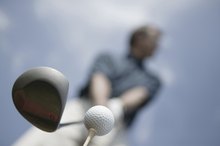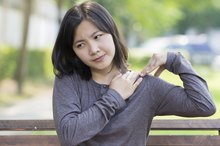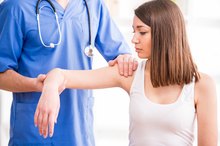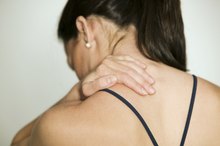Causes of Upper Arm Muscle Pain
Even simple, everyday activities can be difficult when a muscle in your upper arm aches. The cause of your pain may be relatively obvious, particularly if your pain started suddenly in association with a traumatic injury or recent heavy lifting.
Other causes of upper arm muscle pain, such as a shoulder injury, nerve compression or other medical conditions, may not be as readily apparent.
Read more: 10 Ways to Tell Good Pain From Bad Pain
Strain Injury
A strain injury is a common cause of upper arm muscle achiness. This injury occurs when a muscle and/or its associated tendon is overstretched, leading to tearing of the fibers. Strain injuries range from mild to severe, depending on the extent of tearing. A complete tear, or rupture, is the most severe type of strain injury.
Pain associated with a strain occurs immediately or shortly after the injury, which helps differentiate this condition from simple muscle soreness. Activity that involves use of the affected muscle aggravates the pain and rest reduces it.
Other symptoms might also include swelling, stiffness, muscle cramps or spasms, and possibly bruising with more serious strains. Mild strains typically heal within 2 to 3 weeks. Complete healing with a more serious strain can take up to 2 to 3 months. Upper arm strains usually occur due to heavy lifting or overuse of a fatigued muscle.
- A strain injury is a common cause of upper arm muscle achiness.
- Pain associated with a strain occurs immediately or shortly after the injury, which helps differentiate this condition from simple muscle soreness.
Shoulder Injury
Left Arm Muscle Pain With a Golf Swing
Learn More
Inflammation of your shoulder joint and/or the associated tendons may trigger achiness in your upper arm muscles. This pain is typically felt in the outer muscles of your upper arm. The most common cause of this type of pain is shoulder impingement, which involves pinching of the structures between the bones in your shoulder.
Pain in your upper arm typically increases with activity and might decrease with rest. Nighttime pain often occurs with shoulder impingement and there might be limited mobility of the shoulder joint. This condition usually develops due to repetitive overhead work, sports activities or prolonged poor posture with the shoulders rolled forward.
- Inflammation of your shoulder joint and/or the associated tendons may trigger achiness in your upper arm muscles.
- Nighttime pain often occurs with shoulder impingement and there might be limited mobility of the shoulder joint.
Nerve Compression
Nerves exit your spinal cord between each of your vertebrae, the bones of your spine. Cervical spinal nerves exit between the vertebrae in your neck. They supply sensation to the skin and power to the muscles of your arms and hands. The spinal nerve C5 supplies sensation to your upper arm. This nerve can be compressed by a bulging intervertebral disc, a structure that provides padding between the vertebrae.
Arthritis-related bone changes in the neck can also lead to C5 nerve compression. This condition frequently causes pain in the outer aspect of the upper arm. Neck and shoulder pain might also be present. Placing the hand of the affected arm on top of the head might decrease upper arm pain caused by C5 nerve compression.
Read more: How to Relieve Arm Pain Caused by a Pinched Nerve
- Nerves exit your spinal cord between each of your vertebrae, the bones of your spine.
- The spinal nerve C5 supplies sensation to your upper arm.
Humerus Fracture
Signs & Symptoms of a Pinched Nerve in a Shoulder Blade
Learn More
A break in your upper arm bone, the humerus, can cause achiness that you might assume is coming from your muscles. While a traumatic humerus fracture is usually obvious after a fall or forceful blow to your upper arm, the symptoms of a break in this bone can sometimes be subtle.
Hairline stress fractures of the humerus can occur if you frequently play overhead sports — those that involve forceful overhead arm motions, such as tennis, racquetball, handball, volleyball and baseball pitching. Symptoms include progressively increasing upper arm pain with overhead use and achiness at rest.
- A break in your upper arm bone, the humerus, can cause achiness that you might assume is coming from your muscles.
- Hairline stress fractures of the humerus can occur if you frequently play overhead sports — those that involve forceful overhead arm motions, such as tennis, racquetball, handball, volleyball and baseball pitching.
Other Conditions That Cause Pain in the Upper Arm
Upper arm pain that seems to be arising from muscle can occur with several other conditions, including:
- An infection of the humerus
- A noncancerous or cancerous tumor of the humerus
- A blood clot in an upper arm vein
- Heart attack
Read more: 10 Drug-Free Solutions for Every Type of Pain
When to See a Doctor
See your doctor for an accurate diagnosis if you experience upper arm muscle pain. Seek urgent medical care if your arm pain started in association with a traumatic injury, such as a hard blow to your arm or a fall. Seek emergency medical care if your arm pain is accompanied by any warning signs or symptoms, including:
- Difficulty breathing or shortness of breath
- Chest tightness or pain
- Dizziness, lightheadedness or fainting
- Sudden numbness or tingling
- Weakness or paralysis
- Difficulty speaking or understanding others' speech
- A sudden vision change in one or both eyes
- Difficulty walking, loss of balance or poor coordination
Reviewed and revised by: Tina M. St. John, M.D.
Related Articles
References
- Apunts Medicina de l'Esport: Clinical Practice Guide for Muscular Injuries. Epidemiology, Diagnosis, Treatment and Prevention
- Sports Health: Muscle Injuries in Athletes
- HHS Journal: Cervical Radiculopathy - A Review
- American Family Physician: Cervical Radiculopathy: Nonoperative Management of Neck Pain and Radicular Symptoms
- Hospital for Special Surgery: Muscle Injuries: An Overview
- Primer on the Rheumatic Diseases, 13th Edition; John H. Klippel, et al.
- Current Sports Medicine Reports: Humeral Stress Fractures in Overhead Athletes: Pearls for Recognition, Diagnosis, and Management
- Technique in Hand and Upper Extremity Surgery: Management of Medullary Osteomyelitis of the Humerus
- American Academy of Orthopaedic Surgeons: Common Shoulder Injuries
- Iyer S, Kim HJ. Cervical radiculopathy. Curr Rev Musculoskelet Med. 2016;9(3):272-280. doi:10.1007/s12178-016-9349-4
- Caridi JM, Pumberger M, Hughes AP. Cervical radiculopathy: a review. HSS J. 2011;7(3):265-272. doi:10.1007/s11420-011-9218-z
- Munakomi S, Foris LA, Varacallo M. Spinal Stenosis and Neurogenic Claudication. Treasure Island, FL: StatPearls Publishing; 2019.
- Curatolo M, Bogduk N, Ivancic PC, McLean SA, Siegmund GP, Winkelstein BA. The role of tissue damage in whiplash-associated disorders: Discussion paper 1. Spine. 2011;36(25 Suppl):S309-S315. doi:10.1097/BRS.0b013e318238842a
- Suvarnnato T, Puntumetakul R, Uthaikhup S, Boucaut R. Effect of specific deep cervical muscle exercises on functional disability, pain intensity, craniovertebral angle, and neck-muscle strength in chronic mechanical neck pain: a randomized controlled trial. J Pain Res. 2019;12:915-925. doi:10.2147/JPR.S190125
- Kim EK, Kim JS. Correlation between rounded shoulder posture, neck disability indices, and degree of forward head posture. J Phys Therapy Sci. 2016;28(10):2929-2932. doi:10.1589/jpts.28.2929
- Burbank KM, Stevenson JH, Czarnecki GR, Dorfman J. Chronic shoulder pain: part I. Evaluation and diagnosis. Am Fam Physician. 2008;77(4):453-460.
- Burbank KM, Stevenson JH, Czarnecki GR, Dorfman J. Chronic shoulder pain: part II. Treatment. Am Fam Physician. 2008;77(4):493-497.
Writer Bio
Aubrey Bailey has been writing health-related articles since 2009. Her articles have appeared in ADVANCE for Physical Therapy & Rehab Medicine. She holds a Bachelor of Science in physical therapy and Bachelor of Arts in psychology from the University at Buffalo, as well as a post-professional Doctor of Physical Therapy from Utica College. Dr. Bailey is also a certified hand therapist.






